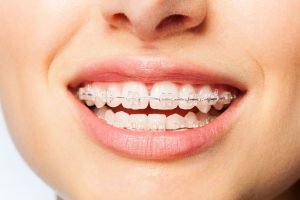An orthodontist receives special training to fix misaligned teeth. An orthodontist must first complete regular dental training and then has an extra four years of specialty training in orthodontics. If you have misalignment in your teeth and/or jaw, a dentist will refer you to an orthodontist.
As permanent teeth begin to replace baby (or primary) teeth, we recommend an orthodontic evaluation. This typically takes place by 7 years of age and the American Association of Orthodontists suggests that children receive an examination by an orthodontist no later than this age.
The orthodontist will look at your child’s teeth, face and jaws to determine proper growth and development. X-rays may be given if recent ones aren’t available or don’t provide the proper angels necessary for evaluation. We are specifically looking at tooth placement, bite and jaw alignment, and the overall development of the mouth and face. If a problem exists, or if one is developing, the orthodontist will advise you on treatment options.
Three common malocclusions (bite problems) are crossbite, crowding and impacted teeth.
Crossbite – A crossbite exists where the top teeth and bottom teeth do not come together or bite in the correct position. Instead, the upper teeth fit inside the lower teeth when the mouth is closed. If the back teeth are affected, the upper teeth sit inside of bottom teeth and this is referred to as a posterior crossbite. In an anterior crossbite, one or more top teeth sit behind the bottom teeth. This should not be confused with an underbite, where all of the top teeth are located behind the bottom teeth and the bottom jaw is pushed strongly forward.

Crowding – Overcrowding of teeth is when there is not enough space in your mouth for your permanent teeth to grow in straight. This can cause misalignment of your bite and teeth.

Impacted Teeth – An impacted tooth is a tooth that does not fully erupt above the gums. This is typically caused by overcrowding, your jaw is too small for all of your teeth or the tooth is erupting in the wrong direction. Not all impacted teeth require oral surgery.

It’s important to remember that orthodontic treatment is a service and not a product. When you purchase orthodontic kits that allow you to perform orthodontic treatment at home, you’re taking on risks that your mouth and bone structure may not respond as anticipated. At home treatment does not begin with a comprehensive evaluation of your orthodontic condition. No x-rays are taken, overlying issues aren’t addressed, and a professional assessment isn’t made that may include more than one type of solution. Additionally, should problems arise during orthodontic treatment, it’s best to have a trained professional who can evaluate your progress and adjust the treatment plan as needed.
A palatal expander, often simply called an “expander” is an orthodontic appliance that fits over several of the top teeth and in the back of the mouth. Using a specialized key, the device is gradually widened to gently encourage more space in the jaw. After the proper placement is made, bones naturally gill the gap and solidify the expansion. Expanders can help with a number of childhood orthopedic problems including crowding, crossbite and impacted teeth (described in greater detail above). They are often required to begin correcting these problems before braces can be used

We provide many different orthodontic treatment options which are personalized to the specific situation of each patient. There are times when several options may be available while some treatments may have only one. Each plan is based on the patient’s age, their activities, the underlying orthodontic issue being treated and other factors such as cost.
Metal Braces are the most common form of traditional orthodontic treatment, however today’s metal braces are smaller and more comfortable than they were in the past. Metal braces are made of high-grade stainless steel and bonded to the teeth. Wires slowly move teeth into alignment over time and frequent evaluations are made to determine proper movement. Patients can personalize their metal braces by choosing the color of their elastics (small rubber bands).

Ceramic Braces are similar in style and function to metal braces but use clear and translucent materials to make them less noticeable. Older teens and adults for whom Invisalign® isn’t an option, may want a less noticeable option and will often choose ceramic braces. It’s important to understand that ceramic braces are more fragile than traditional metal braces and require more care.

Invisalign® treatment uses a series of virtually invisible, removable, and comfortable aligners that allow you to smile more during treatment as well as after. Every 2-3 weeks, patients move to a new set of aligners that help to gradually move teeth into their proper position. Invisalign clear aligners are made with 3D computer imaging technology and have been proven effective.

If a wire, bracket, or band breaks or becomes loose, you will need to take care of it as soon as possible. If the bracket is still attached to your wire, leave it in place and try not to touch it until your repair appointment. If a piece of your braces falls out, bring it with you to your repair appointment. If any part of your braces is causing you discomfort, you can cover them with a piece of dental wax until your appointment.
As braces move your teeth, you may experience minor soreness in your teeth or gums. This is normal! It means that your braces are working and moving your teeth. Most discomfort is very mild and should fade within a few days. To help ease discomfort, you can try using a warm salt water rinse or over the counter medicine such as Tylenol or Advil.
If you have a wire poking your gums, you can take a small amount of your dental wax and place it on the piece of wire that is poking you.
If a wire, bracket, or band breaks or becomes loose, you will need to take care of it as soon as possible. If the bracket is still attached to your wire, leave it in place and try not to touch it until your repair appointment. If a piece of your braces falls out, bring it with you to your repair appointment. If any part of your braces is causing you discomfort, you can cover them with a piece of dental wax until your appointment.
Flossing with braces will require a little more time than your normal flossing. Flossing is very important to make sure you get all food particles from around your brackets and in between your teeth. You may want to use a floss threader to help slide the floss between the wire and your teeth. We recommend you floss every night before bed.
There are several foods you will need to avoid during your orthodontic treatment. You will want to avoid hard foods such as candies, popcorn, nuts, ice, chips, corn on the cob, etc. Hard foods can break your brackets and wires as you bite down on their hard surfaces. You will also want to stay away from sticky foods such as gum, taffy, gummies. Sticky foods can pull your brackets away from your teeth.
Invisalign is a series of clear retainers or “aligners” that are made from intra-oral scans from our iTero scanner. Each tray is made to help your teeth move based on computer predicted tooth movements. Each tray is worn for about 2 weeks and the number of trays can range from 10-40 trays depending on each case. More trays are always provided if the tooth movement predicted on the computer does not match the actual tooth movement in your mouth.